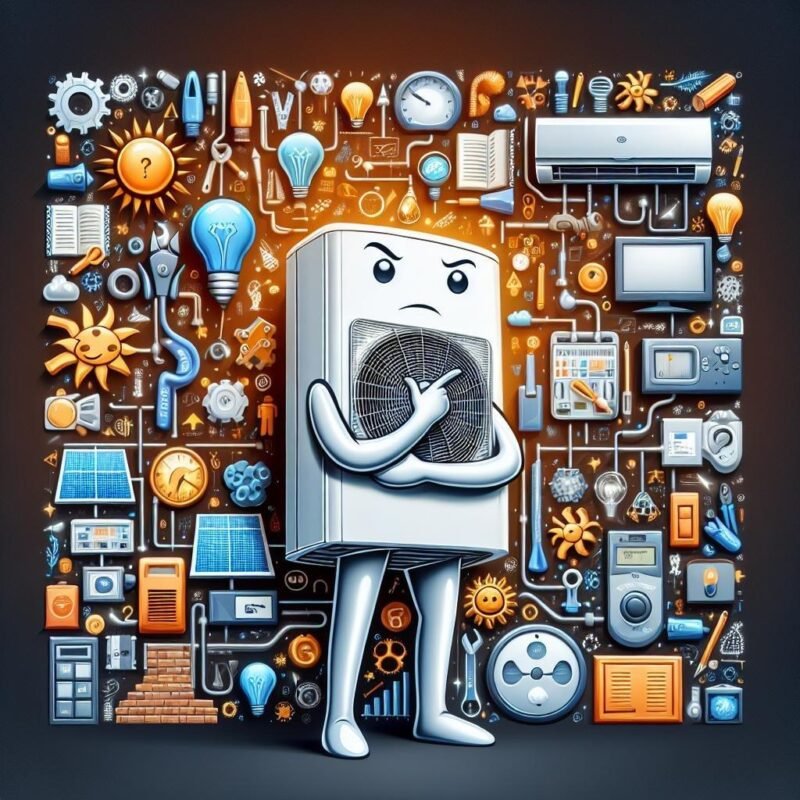Understanding the Different Types of Filters for Mini Split AC Units

Picture this: your mini split AC unit quietly hums away, working its magic too keep your space perfectly agreeable. But hidden within its sleek design lies an unsung hero – the filter. Just like a bouncer at an exclusive club, these remarkable components stand guard, keeping unwanted particles from crashing your comfort party. From basic mesh screens to cutting-edge plasma filters,the world of mini split AC filtration is surprisingly diverse and engaging. Let’s dive into the different types that help keep your air clean and your system running smoothly.
Breaking Down Pre-Filters and HEPA Filters: Your First Line of Defense Against Dust
In the battle against airborne particles, your mini split’s filtration system employs a dynamic duo that works tirelessly to keep your indoor air clean. Pre-filters serve as the first line of defense, capturing larger particles like pet hair, dust bunnies, and visible debris. Think of them as bouncers at an exclusive club, stopping unwanted guests before they can cause trouble. These washable mesh screens not only protect your system’s internal components but also extend the life of the more complex HEPA filters behind them.
When it comes to microscopic invaders, HEPA filters take center stage with their remarkable ability to trap particles as small as 0.3 microns. These high-efficiency warriors employ a complex maze of fiberglass threads that create a unique filtration dance:
- Direct interception catches particles that follow airflow lines
- Inertial impaction stops larger particles that try to slip through
- Diffusion captures the tiniest particles through Brownian motion
| Filter Type | Particle Size Captured | Maintenance Frequency |
|---|---|---|
| Pre-filter | 10+ microns | Monthly cleaning |
| HEPA | 0.3+ microns | 6-12 month replacement |
Advanced Carbon and Photocatalytic Filters: Tackling Odors and Chemical Pollutants
Taking air filtration to the next level, these specialized filters work through a sophisticated process involving activated carbon molecules and photocatalytic oxidation. The activated carbon layer acts like a molecular sponge, effectively trapping household chemicals, cigarette smoke, and persistent cooking odors. When light interacts with the photocatalytic coating, it triggers a chemical reaction that breaks down harmful compounds into harmless substances, creating a cleaner and fresher indoor habitat.
These cutting-edge filters excel at eliminating:
- Volatile organic compounds (VOCs) from paint and cleaning products
- Pet-related odors and dander
- Formaldehyde from new furniture and carpets
- Cooking fumes and persistent food smells
| Filter Component | Primary Function |
|---|---|
| Activated Carbon | Odor and chemical absorption |
| Photocatalytic Layer | Pollutant decomposition |
Washable vs Disposable Filters: Making the Smart Choice for Your Mini Split System
Coming to a crossroads between reusable filters and one-time-use options? Let’s break it down to help you make an informed choice. Washable filters offer long-term cost savings and environmental benefits, typically lasting 2-5 years with proper maintenance. Simply rinse them with water, let them dry completely, and they’re ready to trap more particles.These eco-friendly champions require a bit more hands-on attention but reward you with consistent performance and reduced waste.
On the flip side, disposable filters bring convenience to the table, eliminating the need for cleaning and maintenance. They often feature enhanced filtration technology and can be more effective at capturing smaller particles. Consider these key factors when making your choice:
- Budget considerations (initial cost vs. long-term investment)
- Time available for maintenance
- Environmental impact
- Local air quality needs
| Filter Type | Lifespan | maintenance |
|---|---|---|
| Washable | 2-5 years | Monthly cleaning |
| Disposable | 3-6 months | Replace only |
Maximizing Air Quality: Essential Filter Combinations and Maintenance Tips
elevate your mini split’s performance by strategically combining pre-filters, HEPA filters, and activated carbon filters.this powerhouse trio works in harmony to trap everything from large dust particles to microscopic allergens and unwanted odors. While pre-filters catch visible debris, HEPA filters excel at capturing tiny particles as small as 0.3 microns, and activated carbon filters absorb household smells and harmful gases. For optimal results, consider installing these filters in sequence, allowing each type to perform its specialized function without overwhelming the system.
Keep your filter system running at peak efficiency with a smart maintenance schedule. Monthly cleaning of pre-filters prevents premature clogging of more expensive components,while HEPA filters typically need replacement every 6-12 months. Watch for these tell-tale signs that indicate it’s time for filter maintenance:
- Reduced airflow from your mini split unit
- Unusual sounds during operation
- Increase in dust accumulation around vents
- Unexplained spike in energy bills
| Filter Type | Cleaning Frequency | Replacement schedule |
|---|---|---|
| pre-filter | Monthly | Yearly |
| HEPA | Not recommended | 6-12 months |
| Carbon | Not recommended | 3-6 months |
Q&A
Q&A: Understanding the Different Types of Filters for Mini Split AC Units
Q1: What are mini split AC units,and why are filters critically important?
A: Great question! mini split AC units are compact,flexible air conditioning systems that can cool and heat individual rooms or spaces. Unlike traditional systems that rely on ducts, mini splits have an outdoor condenser and one or more indoor air handlers. Filters are crucial for maintaining air quality and efficiency—they trap dust, allergens, and other contaminants, ensuring that the air you breathe is fresh and clean.Plus, clean filters help your unit run smoothly and save on energy bills!
Q2: What types of filters do mini split AC units use?
A: Mini split systems can use several types of filters, including:
- Washable filters: these are reusable filters that can be cleaned and put back into the unit. they’re eco-friendly and cost-effective!
- HEPA filters: Short for High Efficiency Particulate Air,these filters capture tiny particles,such as pollen and pet dander,making them ideal for allergy sufferers.
- Activated carbon filters: these specialized filters are fantastic for odor removal,absorbing smells from cooking,pets,or smoke.
- Nano filters: Featuring advanced technology, these filters can trap ultra-fine particles, providing some of the highest levels of filtration.
Q3: How frequently enough shoudl I change or clean my mini split filters?
A: It really depends on your usage and environment. As a general rule of thumb, washing or changing your filters every 30 to 60 days is a good practice—especially during peak cooling or heating seasons. If you live in a dusty area or have pets,you might need to check more frequently!
Q4: Can I use any filter for my mini split AC unit?
A: Not so fast! While it might potentially be tempting to grab just any filter,you should always check your manufacturer’s recommendations. Using the wrong filter can restrict airflow or,even worse,damage your unit. Stick to the type of filters that are designed for your specific model, and you’ll be golden!
Q5: What can happen if I don’t clean or replace my filters regularly?
A: Skipping filter maintenance can lead to a poor air quality environment. Think about it: clogged filters reduce airflow and efficiency, causing your mini split to work harder and thus wasting energy. This can lead to higher bills and may even result in costly repairs down the line—yikes!
Q6: Are ther any tips for cleaning my mini split filters?
A: Absolutely! Here’s a quick and easy guide:
- Turn off your unit and unplug it—safety first!
- Remove the filter according to your model instructions.
- Gently rinse the filter with water to remove dust and debris. You can use a mild detergent for stubborn stains.
- Allow the filter to completely dry before putting it back.
- Regularly inspect it for wear and tear, and replace it when necessary. Voila, you’re all set!
Q7: Can I install additional filters in my mini split unit?
A: In most cases, you can, but again, it’s essential to follow your manufacturer’s guidance. some models allow for additional specialized filters, such as HEPA for extra allergen protection.just ensure that these filters fit properly and do not interfere with the unit’s airflow.
Q8: Where can I purchase replacement filters?
A: Replacement filters are generally available through HVAC supply stores,online retailers,or directly from the manufacturer. just remember to double-check the model number to ensure a perfect match.
Q9: Any final tips for maintaining my mini split AC unit?
A: Definitely! beyond just filters, make sure to keep the outdoor unit clean and free from debris, check for any visible signs of wear, and schedule regular professional maintenance for optimal performance. A little love goes a long way in extending the lifespan of your mini split!
That wraps up our Q&A! Whether you’re a first-time mini split owner or a seasoned pro, understanding your filters is essential for comfort and efficiency. Happy cooling!
To Wrap It up
As we wrap up our journey through the world of filters for mini split AC units,we hope you’re feeling informed and empowered to make the best choices for your home comfort.Just like a favourite recipe needs the right ingredients, your mini split system thrives on the right filters to ensure not only optimal cooling but also air quality that keeps your family happy and healthy.
Remember, whether you opt for washable filters, HEPA filters, or something in between, each type has its unique benefits tailored to suit different needs. You’ll not only prolong the life of your AC unit but also enjoy fresher air with every breath.
So, go ahead and dive into that filter maintenance! With a little care and attention, your mini split can be your coolest companion for years to come. If you have any questions or want to share your own filter stories, feel free to reach out. Here’s to a refreshing,comfortable home — one filter at a time!






















